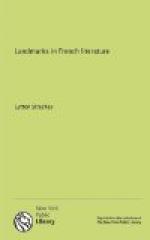Singleness of purpose is the dominating characteristic of the French classical drama, and of Racine’s in particular; and this singleness shows itself not only in the action and its accessories, but in the whole tone of the piece. Unity of tone is, in fact, a more important element in a play than any other unity. To obtain it Racine and his school avoided both the extreme contrasts and the displays of physical action which the Elizabethans delighted in. The mixture of comedy and tragedy was abhorrent to Racine, not because it was bad in itself, but because it must have shattered the unity of his tone; and for the same reason he preferred not to produce before the audience the most exciting and disturbing circumstances of his plots, but to present them indirectly, by means of description. Now it is clear that the great danger lying before a dramatist who employs these methods is the danger of dullness. Unity of tone is an excellent thing, but if the tone is a tedious one, it is better to avoid it. Unfortunately Racine’s successors in Classical Tragedy did not realize this truth. They did not understand the difficult art of keeping interest alive without variety of mood, and consequently their works are now almost unreadable. The truth is that they were deluded by the apparent ease with which Racine accomplished this difficult task. Having inherited his manner, they were content; they forgot that there was something else which they had not inherited—his genius.
Closely connected with this difficulty there was another over which Racine triumphed no less completely, and which proved equally fatal to his successors. Hitherto we have been discussing the purely dramatic aspect of classical tragedy; we must not forget that this drama was also literary. The problem that Racine had to solve was complicated by the fact that he was working, not only with a restricted dramatic system, but with a restricted language. His vocabulary was an incredibly small one—the smallest, beyond a doubt, that ever a great poet had to deal with. But that was not all: the machinery of his verse was hampered by a thousand traditional restraints; artificial rules of every kind hedged round his inspiration; if he were to soar at all, he must soar in shackles. Yet, even here, Racine succeeded: he did soar—though it is difficult at first for the English reader to believe it. And here precisely similar considerations apply, as in the case of Racine’s dramatic method. In both instances the English reader is looking for variety, surprise, elaboration; and when he is given, instead, simplicity, clarity, ease, he is apt to see nothing but insipidity and flatness. Racine’s poetry differs as much from Shakespeare’s as some calm-flowing river of the plain from a turbulent mountain torrent. To the dwellers in the mountain the smooth river may seem at first unimpressive. But still waters run deep; and the proverb applies with peculiar truth to the poetry of Racine.




